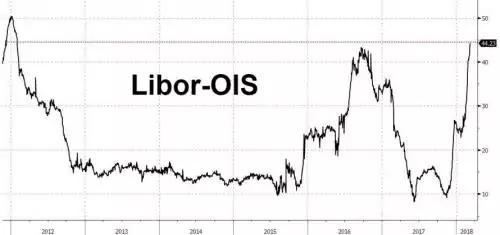Libor-OIS – What It Is and Why It Matters
News
|
Posted 13/03/2018
|
8341
We regularly pass on warnings that financial markets throw off of impending trouble. At the moment that is a very broad array of metrics including sky high valuations, spiking volatility, and flattening yield curves.
Indeed we were struck by a comment posted yesterday by PSP Investments’ global head of private investments, Guthrie Stewart - "We’re watching a movie where we know what the ending is. Just not how long it is until we get there."
As another twist in that ‘movie’ there is now another flashing warning sign that isn’t on most investor’s radars but is worth noting and understanding. It is the Libor-OIS spread, and it just hit a 6 year high, coinciding with the 2012 Euro debt crisis:

Bloomberg recently published an article titled “Why It Matters That the Libor-OIS Spread Is Widening” and it is worth repeating below as a good education piece:
“Short-term borrowing costs in the U.S. have risen to levels unseen since the financial crisis, and recent moves in two closely watched indicators -- the London interbank offered rate and its spread with the Overnight Index Swap rate -- are causing some consternation. The spread has expanded to its widest level in more than a year, raising questions about whether risks might be brewing within credit markets. While the recent widening may be technical and doesn’t suggest a systemic risk, several factors in funding markets are likely to prevent a “lasting retracement,” according to analysts.
1. What is Libor?
The London interbank offered rate, or Libor, is a benchmark that’s regarded as a gauge of credit market conditions. Every day, various major banks submit to an administrator estimates of what interest rate they would have to pay to borrow in the interbank market, and these are compiled to establish benchmark rates in five different currencies across seven different loan periods. Those benchmarks underpin interest rates on a range of financial instruments and products from student and car loans to mortgages and credit cards.
2. What’s OIS?
The Overnight Index Swap rate is calculated from contracts in which investors swap fixed- and floating-rate cash flows. Some of the most commonly used swap rates relate to the Federal Reserve’s main interest-rate target, and those are regarded as proxies for where markets see U.S. central bank policy headed at various points in the future.
3. Why does the Libor-OIS spread matter?
It’s regarded as a measure of how expensive or cheap it will be for banks to borrow, as shown by Libor, relative to a risk-free rate, the kind that’s paid by highly rated sovereign borrowers such as the U.S. government. The Libor-OIS spread provides a more complete picture of how the market is viewing credit conditions because it strips out the effects of underlying interest-rate moves, which are in turn affected by factors such as central bank policy, inflation and growth expectations.
4. Why are people worried?
The Libor rate for three-month loans in dollars has climbed to 2.03 percent, a level it hasn’t reached since 2008. Its spread over the OIS rate has also widened quite dramatically following a Congressional deal on the U.S. budget and debt ceiling on Feb. 8. That gap widened by 15 basis points in February and was at 44 basis points on March 9. It is the speed of the move that is giving some investors pause for thought.
5. What pushed it up?
Several factors. One has to do with the torrent of Treasury bill supply that the government has unleashed since lawmakers last month resolved their impasse over the nation’s borrowing limit. With that crisis passed, the Treasury has been replenishing its cash balance and that has meant a flood of debt sales, particularly of shorter-dated securities. That has driven up borrowing costs not just for Uncle Sam, but also for other borrowers in the short-term market who rely on instruments such as repurchase agreements and commercial paper.
6. So that’s the only reason it’s widening?
No, the tax legislation passed by Congress in December is also playing a role. The new law offers incentives forcorporations to bring money back to the U.S. that they had previously stashed overseas. Much of that offshore hoard has tended to be kept in short-term instruments like commercial and bank paper, and a dwindling of those overseas cash piles is likely to mean reduced demand for these products. And that means higher borrowing costs.
7. Anything else?
Yes. The Federal Reserve is shrinking its $4.4 trillion balance sheet, which means there will be less reserves sloshing around in the financial system. As the U.S. central bank pulls back from providing support, banks are going to have to compete more for funding, and that could force short-term rates higher.”